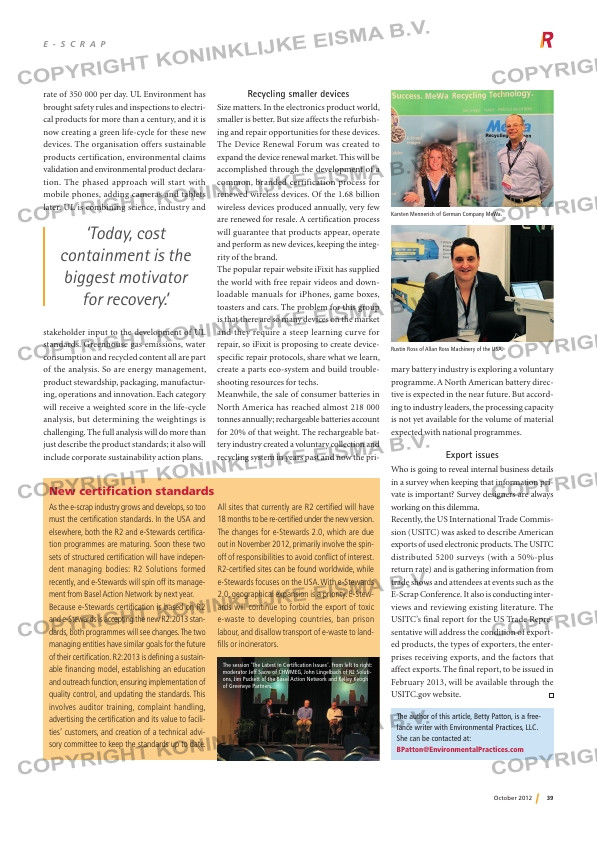Page 39 from: October 2012

39October 2012
E – S C R A P
rate of 350 000 per day. UL Environment has
brought safety rules and inspections to electri-
cal products for more than a century, and it is
now creating a green life-cycle for these new
devices. The organisation offers sustainable
products certification, environmental claims
validation and environmental product declara-
tion. The phased approach will start with
mobile phones, adding cameras and tablets
later. UL is combining science, industry and
stakeholder input to the development of UL
standards. Greenhouse gas emissions, water
consumption and recycled content all are part
of the analysis. So are energy management,
product stewardship, packaging, manufactur-
ing, operations and innovation. Each category
will receive a weighted score in the life-cycle
analysis, but determining the weightings is
challenging. The full analysis will do more than
just describe the product standards; it also will
include corporate sustainability action plans.
Recycling smaller devices
Size matters. In the electronics product world,
smaller is better. But size affects the refurbish-
ing and repair opportunities for these devices.
The Device Renewal Forum was created to
expand the device renewal market. This will be
accomplished through the development of a
common, branded certification process for
renewed wireless devices. Of the 1.68 billion
wireless devices produced annually, very few
are renewed for resale. A certification process
will guarantee that products appear, operate
and perform as new devices, keeping the integ-
rity of the brand.
The popular repair website iFixit has supplied
the world with free repair videos and down-
loadable manuals for iPhones, game boxes,
toasters and cars. The problem for this group
is that there are so many devices on the market
and they require a steep learning curve for
repair, so iFixit is proposing to create device-
specific repair protocols, share what we learn,
create a parts eco-system and build trouble-
shooting resources for techs.
Meanwhile, the sale of consumer batteries in
North America has reached almost 218 000
tonnes annually; rechargeable batteries account
for 20% of that weight. The rechargeable bat-
tery industry created a voluntary collection and
recycling system in years past and now the pri-
mary battery industry is exploring a voluntary
programme. A North American battery direc-
tive is expected in the near future. But accord-
ing to industry leaders, the processing capacity
is not yet available for the volume of material
expected with national programmes.
Export issues
Who is going to reveal internal business details
in a survey when keeping that information pri-
vate is important? Survey designers are always
working on this dilemma.
Recently, the US International Trade Commis-
sion (USITC) was asked to describe American
exports of used electronic products. The USITC
distributed 5200 surveys (with a 50%-plus
return rate) and is gathering information from
trade shows and attendees at events such as the
E-Scrap Conference. It also is conducting inter-
views and reviewing existing literature. The
USITC’s final report for the US Trade Repre-
sentative will address the condition of export-
ed products, the types of exporters, the enter-
prises receiving exports, and the factors that
affect exports. The final report, to be issued in
February 2013, will be available through the
USITC.gov website.
The author of this article, Betty Patton, is a free-
lance writer with Environmental Practices, LLC.
She can be contacted at:
[email protected]
‘Today, cost
containment is the
biggest motivator
for recovery.’
New certification standards
As the e-scrap industry grows and develops, so too
must the certification standards. In the USA and
elsewhere, both the R2 and e-Stewards certifica-
tion programmes are maturing. Soon these two
sets of structured certification will have indepen-
dent managing bodies: R2 Solutions formed
recently, and e-Stewards will spin off its manage-
ment from Basel Action Network by next year.
Because e-Stewards certification is based on R2
and e-Stewards is accepting the new R2:2013 stan-
dards, both programmes will see changes. The two
managing entities have similar goals for the future
of their certification. R2:2013 is defining a sustain-
able financing model, establishing an education
and outreach function, ensuring implementation of
quality control, and updating the standards. This
involves auditor training, complaint handling,
advertising the certification and its value to facili-
ties’ customers, and creation of a technical advi-
sory committee to keep the standards up to date.
All sites that currently are R2 certified will have
18 months to be re-certified under the new version.
The changes for e-Stewards 2.0, which are due
out in November 2012, primarily involve the spin-
off of responsibilities to avoid conflict of interest.
R2-certified sites can be found worldwide, while
e-Stewards focuses on the USA. With e-Stewards
2.0, geographical expansion is a priority. E-Stew-
ards will continue to forbid the export of toxic
e-waste to developing countries, ban prison
labour, and disallow transport of e-waste to land-
fills or incinerators.
The session ‘The Latest in Certification Issues’. From left to right:
moderator Jeff Sacre of CHWMEG, John Lingelbach of R2 Soluti-
ons, Jim Puckett of the Basel Action Network and Kelley Keogh
of Greeneye Partners.
Karsten Mennerich of German Company MeWa.
Rustin Ross of Allan Ross Machinery of the USA.
R _8- – -n .indd 39 09-10-12 11: 3



